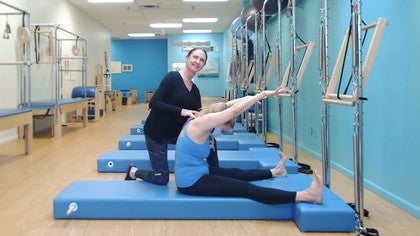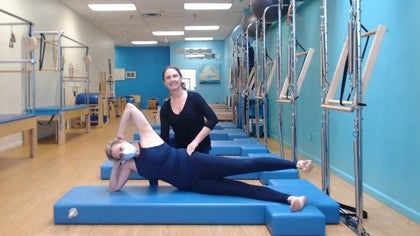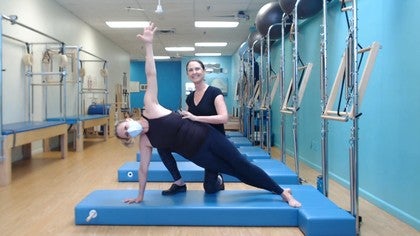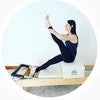Description
About This Video
Transcript
Read Full Transcript
Hi, everybody. Welcome, I'm Amy Taylor Alpers from the Pilates Center in Boulder, Colorado. We're gonna have a wonderful discussion today that I really hope gonna stimulates some of your, I don't know I guess increases your belief system in how Pilates can heal. I spent many, there were a number of years where I thought someday I'm gonna dive into this topic and then I had an opportunity to do it couple years ago, and has found that this is just really intriguing view into the body. So that when you're watching clients move you have other things to look at besides technique.
So this organ to spine connection that we're gonna talk about today really looking how at, how each vertebrae in the spine correlates to very specific organs, and systems. And consequently upping, hopefully upping your commitment to the idea that a spine really has to be healthy. And I know that that can be scary sometimes because spines have scary things in them. But in general what Pilates does is so incredibly healing, that you know we as Pilates teachers I think really need to feel a little more confident working with spines. So I do have a picture that they're gonna put up for you that I wanna give you a little bit time to study, just a minute or so.
Feel free to take a screenshot of that if you want. And it's just showing you kinda what we're gonna be talking about today in terms of a spine all the way from the brain down the spinal cord, and then out into the nervous system where it's connecting to the various organs and systems in your body, right. And it does correlate pretty much straight down, so it's not like you have to memorize all that, but it can be intriguing sometimes if you know somebody has an issue in a certain place in their spine to look at what organ or what system that might be affecting. But you'll see that it does kinda correlate down where the nervous system coming out of the spine is going pretty much to organs right in that area. So it's not like something that comes out of the neck goes all the way down into the hips or something like that, right, so it's pretty straightforward on that level.
And there are lots of other images like this, which have a lot more detail, plenty of information for a lifetimes of study there, but just enough for you to get a sense of when we're talking about spines in roll up, in roll over, in spine stretch, and every other place in Pilates that we are actually very much touching on organs and systems that affect peoples health. Okay, so hopefully you've had enough time with that image. And I just have the skeleton here for you to maybe take a moment where you could imagine it maybe life size and on an actual spine, right, so that we're seeing all of the nerves that come out between the vertebrae, and there's nerves that go two things and nerves that come back, and obviously it's going to muscles as well. But we're talking a little more specifically about organs and the nervous system today but you can certainly see that areas in the spine could affect the way muscles are operating. So out of each joint there are nerves coming out and they're going directly to heart, lungs, stomach, liver, kidneys.
Kidneys in the back are kind of a big one because a lot of the work we do in Pilates we're kind of tight right in here, and so getting the kidneys to move and this be massaged, et cetera by your breath but also by your flexion, and your extension, and your rotation, et cetera, right. And then down into obviously the intestines, the bladder, et cetera, sex organs down low, all of it very much affected by the spine. And so we're gonna just watch Pilates through that mirror today or through that lens today, and see if we can't, you know facilitate a spine to move more effectively because now we really are clear that it's incredibly important that it does, okay. So we're gonna move our skeleton away, and we're gonna have the fabulous Sue come and join us. And I want to take a moment just to kind of establish our idea a little bit more before we actual just start moving.
We're just gonna do a kinda steady, nice, slow, well-paced intermediate level mat, nothing too crazy or hard today with a good focus on what we're talking about. Okay, so Sue's gonna take here feet out, and you can just join us on your floor or your mat. And we won't even use the arms, let's keep the arms down. And now you just want to feel, go inside your own body, and begin to just curl down, right, so you feel that you bend each one, each one, and then you go into, so we have our seven, and then we've got 12 in here, right, and we're trying to make sure that we actual bend them exactly, right. And then we're going down, and we're bending even a little more, so that the bending is more than leaning, right.
So you could almost feel like you're getting a little bit shorter in a way, so that you actually bend them all. And then when you roll back up you start front of the sacrum right up from the lumbar, up the spine and all the way through. So if you think of it a little less as an exercise that has a lot of technique involved and a little bit more of a movement that designed to simulate and flex the spine in a way that heals the spine, keeps the spine healthy. Let's think about it a little more that way today because there's a lot of rules and regulations about it that sometimes actually impede the task. Okay, so let's try it again.
So you take nice inhale, and then you exhale, and you start right at the occiput, and just bend them each, and feel like you're flexing, in other words there's little muscles that actually bend the joint, and you wanna feel like it's a little less for it since the weight of your body pulls you down, that does help, but more that little tiny muscles inside actually flex you. And you feel your abdominals begin to contract in a way that pulls you down, right. And then you feel almost like I exhaled until I am completely like an accordion closing, and then the inhale becomes really reactive, it's like I have to inhale. Okay, so let's do one more, and we'll go with a little more breath rhythm this time. So take a big inhale, and then you're gonna exhale, exhale each vertebra all the way down.
You're gonna soften, keep goin' a little bit more all the way, all the way, all the way, all the way, and then you inhale back up again, all right. And at the begin of course, you know we're gonna start, we're gonna be movin' as best we can, and then as you warm up, and do another exercise, and another exercise then you begin to really feel like your spine is by the end of the class fabulous. Okay, all right, so I'm gonna go ahead and lie down. We'll take a nice kind of easier hundred today. Okay, so you're just gonna bend your knees into your chest, and take a moment here, relax your spine.
See if you could notice that you're holding tension in your spine, and instead try to relax the spine so the skeleton feels quite, almost nonexistent in a way, and then the muscles can pick it up a little bit more effectively. If we've got too much tension in our spine or any of our joints then muscles can't really do their job, which is to move the skeleton and massage things, okay. So let's take a nice inhale here, and then we'll exhale, take the legs out on a diagonal and curl up, and then we're gonna take our hundred. So we go in, two, three, four, five, and out, two. And Sue is the queen, this is Sue, she's the queen of counting, so she'll count for us. (laughing) All right, so I'm gonna come up just a little bit, maybe turn in slightly, okay.
She has incredibly long legs, so we're just gonna help her hold herself over here, yes. Maybe a little softer arms. You could even shrug your shoulder just slightly. Yeah, just a little, right, so that we could really bend. You got it.
And then you could pretend almost like some leg springs from above your head, and press down into them. Yeah, to get the backside, which could help to anchor her a little bit. Last one. So she could, and then you can bend your knees or lower your legs, whatever feels good. Okay, so roll on up.
We're gonna put your feet under the straps, but offset. And there's a, oh, shoot, we should of fixed that first. There we go. And there's a roll up bar, so if you have a roll up bar, awesome. Okay, and we're gonna take the bar up and then over.
Take a moment again relax your spine. See if you could just let it go, and then bend your spine. So you're gonna lift the bar, and you're gonna roll, and we're gonna see all of those places, first one is always a little bit like I don't know how it's gonna go today. And we're going to try not to throw, so you're gonna roll, and you're going to bend. Beautiful, yes.
And you bend every single one of them. And if you can follow it through, you think- Whoops. I am, that's okay, I am bending, massaging, and stimulating my brain, my heart, my lungs, my stomach, my liver. Getting a nice opening through the kidneys, pulling in through the intestines, deep, and massaging. And let's do two more, and just focus on that.
Focus on how when you flex a vertebrae you massage deep into your nervous system and deep into your organs. And let's, a little narrower hands, and then just slightly softer arms, so you can bend more. Nice, nice, nice, nice, okay, great. All right, that's enough that. Okay, so let's put the bar down.
Let's do roll over. Okay, so you're going to bend your knees into your chest, and again we're not trying to do the world's most fantastic roll over according to the rules and regulations. Straighten the legs. We're trying to bend the spine and massage your organs, right. So your tailbone curls, your lumbar curls, thoracic curl, and then you roll down, and you really feel nice together, just watch those long legs.
And up and over. And she's massaging her entire spinal cord, which runs through, right, as well as the entire nervous system that comes out of the spinal cord. And then we'll reverse. And you inhale, bending your vertebrae, massaging down through. Open, you feel your intestines, you feel your stomach, your liver, your kidneys.
And last time, and last time we'll just stay over for a moment. If you can have your feet on the floor, awesome. Reach around and take the back of your ankles, and even if the feet are not on the floor that's fine. And just do an extra slow roll down, right, so that you feel through the cervicals, and each vertebrae. And maybe you take this little extra time right here to go bit deeper into one or the other, or however which ones there are that have a little extra tightness in them, right.
So it's nice, especially morning, it's very nice to take a little extra time to get your spine moving. We're gonna scoot back, we're gonna do tree on the mat. Now if you're at home, and you have something like a sandbag, a nice heavy weight, very, very nice during this pandemic times to have something like an ankle weight or sandbag if you don't have a strap. Okay, so we're gonna bend the knee in, and straighten the leg up, and then we're going to take behind the thigh, and bend the spine once again. And you could really feel like you are, each vertebrae, one at a time, the sacrum deep into the lumbar, put your back down in, and back.
And again, inhale, flexing the joints, massaging the organs. Beautiful, Sue. And back down, deep into your spine, gorgeous. And one more time, nice breath, just, you're not trying to get good at it, you're trying to massage and flex every joint, and stimulate every nerve and every organ. Now with the single leg circle we actually teach it with a twist, so once again you're twisting the entire nervous system, the entire spine, all of the organs.
So you're coming across, we're gonna pick the hip up a little more, and then circle down, and watch your toes, and come back to center. And think of it as a gut massage, think of it as a spinal twist. And Sue, let's watch your foot there. And around, and down, and up, two more. Big inhales, exhales, and feel like the whole thing is a huge massage.
Reverse, down, and around. You can come way over, and exhale. And if you come over far enough, right, and you bring your hip a little more, and you come up a little high. Sue's very flexible, but most of us if we come high enough it actual gets into the guts a little bit more. And cross over and exhale, yes.
Two more, big inhale, exhale, and last time, and nice. And then just bend the knee, give it a little squeeze, and we'll switch. Okay, nice job. And the other leg comes in, and up, and then you bend, and massage, and keep flexing. And even here so you might curl more, yeah.
And then walk down, yes. That's right, the elbows stay high like that, which is nice, which keeps the lungs open. Yeah, there you go, beautiful. And exhale, and last time. And every single time you bend a spine you get benefit so it's worth it.
And then deep flexion, flexion, yes, gorgeous. Okay, arms are down, and we're gonna circle, over, down, around. And you're just concentrating more on the twist of the spine and the deep visceral massage that you get stimulating all your organs, stimulating all your nerves. And then last one, and reverse, and around, and over, and center, and around. And the farther over and higher you go, even if you have to bend your knee a little bit, you can get in a little deeper to the massage of the organs.
Nice job. And last one. Thanks for counting. And we're gonna bend the knee, you're gonna roll up through your spine, that's right. And then we'll pick the hips up and move 'em forward to the heels, and have even that be a moment when you flex a little bit more, right.
Then you're come up on your tiptoes, you're gonna bend into your flexion, and then you're gonna roll through every vertebrae and massage, right. And the lungs and the breathing, beautiful, also put a little expansion and contraction on the vertebrae themselves, right, and you can feel that. You can inhale and stretch your spine a little bit, exhale, and feel it return. Squeeze, and let's just do one more. Exhale, very nice.
All right, you're gonna put your feet down, your hands down, pick your butt up, and lie down by rolling through your spine. Now we switch and switch, you can go ahead and begin, we're gonna do just five sets of each. And I want you to take just a little more on the, stay for one second, on the curl lift, yeah, pull yourself into your curl. You got it. So you know that you're using your abs to massage.
And then we'll do the double leg. Inhale, out, and exhale, in. And it's more about the breathing and the spine lengthening, and the spine flexing than it is about even just making your abs strong. All right, last one, good. And then we go into scissors.
Pull twice, switch, pull twice. Now stay for one second, take your hands a little higher, and pull yourself into it as well, that's right. And switch from your guts, from your guts, that's the way, and switch, and switch, and switch, good. Be even, and then hands behind your head. Inhale, take the legs down, and maybe even do almost a tiny roll up, and then squeeze your guts.
And inhale a little tiny roll up, and squeeze your guts. Good, now more squeeze less sound is somethin' I say. Right, inhale, big lungs, powerful contraction, beautiful. Last one, and then we take the whole thing and twist it, and twist, and twist. And you're really tryin' to get a good twist of the spine, twist of the nervous, nice, Sue, twist of the guts, and be even, beautiful.
And roll up to sitting, nice. Okay, so now this spine stretch should feel fabulous, it's very different to do it after you've warmed up that much. All right, so we'll go with the arms now, so we're gonna take the arms up, big inhale, and then exhale, flex cervicals, thoracic, and lumbar, and go as low as you can. And today even though it's called spine stretch we're gonna not stretch, we're gonna relax the shoulders, we're gonna shorten the back a little bit, and we're just gonna flex. So we're goin' down, down, down, and then we inhale back up.
See if you can take all the stretch out of it and just flex, and flex in. You got it. And stay flexed in, and then flex down. Keep going, keep going, keep going. And then inhale back up, and exhale, every joint, every vertebrae, every single moment were a nerve comes out of your spine gets massaged and then start way deep.
And last one, and the exhale, that's it, Sue. And even sit back into it a little bit more, that's right, and go down, down, down, down, gorgeous. And inflate back up again, really nice. So it can be cleansing and emptying or it can be stretchy and kind of tightening a little bit, so just relax the tension of it, and use muscles to contract and flex. All right, so you're gonna just curl back a little bit, point your toes, bend your knees, slide your feet in, and straighten your legs.
Now you're gonna roll through that amazingly flexible spine. In, and out, beautiful, in. And maybe for some of you who might have really long legs like Sue, just kinda relax the length of your legs. You can keep them straight and pointed, but don't necessarily make 'em longer. And focus on flexing your abs, flexing your spine, rolling through your spine, nice job.
Breathing, inhaling, and we'll do one last one. See very nice. So it's not as tense, right, it's a little more like you're in control. All right, and then we're gonna just bring the feet together, we'll keep 'em up, and we'll lie down. All right, so now corkscrew obviously is a really good spinal massager.
All right, so let's Jack knife up, we'll have legs go parallel to the floor, and we'll start going down to the right. You twist every vertebrae, you roll down the right side of your spine, you circle over, you go up the left side, and flex every single one. And you twist to the left, and you roll down. And hopefully you're thinking more about what's going on with the muscles that flex your spine, twist, than you are necessarily about doing the most world's perfect corkscrew. You're tryin' to reap the most benefit from it.
Twist, and around, and abdominals grab and squeeze. And we're gonna do one more set. Deep massage for every organ, all of your nervous system, as well as your muscles. And last one, exhale, deep squeeze it, beautiful. And roll right on up, and take your legs out in a V, and your arms out to the side, so once again mega twist and flexion for your spine.
So you're gonna twist to the right, you're going to deeply flex, deeply flex, and twist, and come back up, and around. And you really can feel how this back arm even can help your twist, and keep you from overstretching because instead you're flexing. That's gorgeous, there we go. And come back up, big breath. If you get all out, squeeze, squeeze, squeeze, squeeze, squeeze, squeeze, squeeze, then the inhale just feels like a response.
And one more set, deep squeeze all the way. And start cervical, thoracic give your heart and your lungs a little massage here, and come back up. Really nice. Okay, and then let's just swing your feet around, and we'll lie on your belly, good. And we're gonna take just a little pause here because swan is probably one of the biggest issues that people have.
Not everybody has an issue but it's common and it's worldwide. And we very commonly miss some vertebrae. Okay, so we're gonna start again, maybe we just pick the face up a little bit to get the head even, and then we start to lift here, all right, so you're gonna lift your, and look up, and bend, and bend, and bend, and then bend in these. These are the hard ones for many of us, so stay here and just relax this down, that's the way, right, so that you're bending. Bend, don't lift so much, bend that, right.
And the image that you use a lot is that if you were on a Ferris wheel, right, the cart that's just in front of you that's headed down and forward is the one you're focusing on, that's the vertebrae, yes, that you're bending. Right, so we'll do that one again, kinda slowly, then we'll take it up to tempo. So if this is the one you're bending, this is one the on the Ferris wheel that's going down and forward, and then the next one, and then the next one. And then we get to these where we try to brace a little bit, instead you're gonna take the next one down and forward, that's right, down and forward, beautiful, down and forward. Go, Sue.
Right, so the spine actually goes around, and then come back down. And then we'll do three up to tempo, okay, but you're trying not to miss 'em even if it's up to speed. You feel all of them, you do less lifting, and more bending backwards. And you try to find those crazy hard ones right in there, yep, yep, and you come back down. We'll do two more.
And you actually feel the little teeny muscles between each vertebrae, that's the way, and down, and last one. And you feel 'em again, right. You feel real flexion. Those top thoracic ones we really tend to miss. Beautiful, and back down again.
Very, very nice. And then let's sit back in a little child's pose, and just take a little brief release. But even here we have a little tendency to stretch, and what if in fact we just relaxed. Like if you could just imagine the skeleton at rest, it's just sitting there, not a lot of tension. And then you can roll right back out onto your elbows, and we'll single leg kick.
Now again same idea, and I'd rather you maybe feel like you're little extra low today, so that you can extend your spine, that's right. And you wanna even feel like the glutes are a little bit apart of the spinal extension, right, so that upper line of the tights is part of the lumbar spine a little bit. And then you're gonna pick up one leg, kick, kick, switch, kick, switch, kick. And you keep gently pulling yourself forward, that's right, which meant increase the extension a little bit. Yeah, exactly.
And help pull you, nice job, inhale for two, and exhale for two, and one more set. And finish, nice job, all right. And then one cheek on the mat, hands high up on your back. So by now hopefully we feel like our spines are amazing. Take a big inhale, and we go kick one, two, three, and then just arch your back, and exhale, two, three, and inhale, arch your back.
Feel all those fabulous back muscles in between every vertebrae, yes. And you feel along the front of the spine, a nice length because, yes, flexion is not the same thing as compression. Beautiful, Sue. And finish your last one. And a nice big, like a huge yawn.
That feels so good in your spine. Nice job. All right, and then let's go ahead back into another child's pose for just a second. We'll take a little breather here. And rest, rest your whole spine.
Relax your knees, and your shins, and your ankles. And then let's even walk your hands over to the right and drop your hips off the left a little bit. And not too stretchy, more bendy. What's the difference, right? So I think that's a big conversation, the difference between bending and stretching.
And we'll go to the other side. Bending is just using contracting muscles to move a joint. Stretching is pulling on things. And we don't really wanna pull on things. And then you can come to center and pull your belly up.
Now bring your feet out in front of you, and we'll do neck pull. And another conversation that's big, the difference between bending and stretching is also the difference between contracting and griping, right. So if we are just contracting then the skeleton just comes along for a ride. So we're gonna curl up, and we all know that one's hard, especially in that tricky area. Then you're gonna unfurl it, little less back extension, yes.
Hip extension and abdominals take your long spine down. Beautiful, Sue. And again up, and think of coming up, let's stay here for one moment, and take your fingertips, and put them on your upper thoracic. You can go right under your straps. And then pull that over, and feel, and then at the same time a little curl back in the low belly, right, and the head comes down, and you're, like you're trying to take your shirt off over your back, right.
So when you start up from the floor we'll feel that again. You can leave 'em right there, and just kinda lift yourself up. Beautiful, beautiful, right. And then the initiation should feel, oh, nice job, like you're picking this all up, and flexing it forward. Beautiful.
And then lay it out nice and long, keep liftin' it up. Yeah, yeah, yeah, yeah, yeah, right. So that you're, so when we start that curl we don't kinda run into, whatever that sticky spot is right here, right, but that instead this comes up and over, which allows these to flex. And then we get the strength here, and the release of tightness or whatever it is that's blocking our smooth flexion through. Okay, and then we're gonna go into Jack knife.
All right, so now we're gonna do same idea, we're not gonna just do Jack knife according to every rule we ever heard, when they're are many. We're going to bend our spines and flex through, and massage our organs, and our nervous system, and then you can pick the whole thing up, and here you might feel that same opening in the back of the neck, which helps you begin to flex down through your spine. Nice job. And over, and up. Yeah, and you can feel like an accordion where you can elongate, and then you can flex, and come down.
Now last time, Sue, again this first little part right here curl through it, roll through it, beautiful. Yeah, so that you don't miss a joint. And then you flex heart, lungs, stomach, liver, down into the intestines. Nice job. Okay, and then we'll rest there.
All right, nice. Let's go into some side kicks. All right, so want you, you lie on your right side, and we'll pull the box up a little bit. Pulling the box up just so you don't, with Sue's long legs kick all the springs. All right, so now on this exercise there's lots of confusion, and theories, et cetera, but I don't like to see the spine swag like this, this is really common, I do it myself.
So we're just gonna pull the spine, so if you could imagine your spine from the back it's relatively straight, and you're holding it with your abs, right, yes. So that when you pick this leg up it's actually attached to your abs, right, rather than hanging off. So you hold the spine nice and strongly, not hard but strong. And you go to the front, and to the back, nice. And the spine does reflect a little bit exactly, but you can get the glute up into the lumbar to take the leg a little farther, that's right, and we come to the front, front.
Because of piece why we have a little trouble with our extension is that that upper glute is not really working so well, and it should be a powerful, go you, Sue, wow, a powerful support for your lumbar. And because we kind of taught ourselves to turn it off a little bit, yeah, so this all comes right up into the contraction, the same contraction we felt in swan and in spine stretch. Beautiful. And then last one, big inhale to the front. All right, and now we're gonna turn out and kick up to the side.
Now the side can be even a little tricker because we want to hang again, right. So we're just trying to stay as organized as we can, which I know is very challenging, and use this upper glute again, so it isn't just quad, beautiful. Yeah, and that you have a sense a little bit of that roll up feeling in your back, right, where you're lifted up into your arms instead of resting down. Reverse your foot, you got it. Inhale, and exhale, inhale, and exhale.
Two more, and up, very nice. Okay, let's go parallel legs, and let's do double leg lower lift, all right. And even though it could feel like it's a leg exercise make it more spinal, so grab the whole length of your spine with your powerful abdominals, and side bend way up here, right, which is really challenging when you're long. Up we go, right, so you're using that glute but you're using your obliques like crazy, and you're actually feeling this as a slight side bend in your spine. Yes, good job.
And then we'll stay up, and we'll lower and lift the bottom leg, and you're just holding this whole strong torso with strong muscles. You got it, nice. Let's stay up, let's flex the feet, turn out, and do some claps, and then point the feet but keep your turn out. And one more set, flex the feet, and then point the feet, and then just stay here for a moment still, we'll roll onto your belly. You can go hands under your forehead or hands under your hips.
Actually today let's do it under your hips because sometimes this can give you a little better access to the upper glutes, right. So you're gonna pick the legs up, you're gonna turn the legs out. And the turn out is way up here, yeah. And you're kind of pushing yourself that way, and then you do your kicks from way up high, so it's a little less even leggy, and it's more hippy and glutey, and strong back muscles. You got it.
Deep breath in, and then exhale, and rest. Beautiful, Sue. All right, and then let's just have you flip to the other side, so we'll stay facing front, yeah. And then just grab your box and slide it down, perfect. All right, so and we're off in a little different side to side, so again, right, we see the tendency because we don't really conform to flat that well, and then we tend to of course wanna roll back a little bit.
So we're gonna go up and forward, and stay nice and high right in here, and under. And we go to the front, front, and around to the back, back. And if we can get a little more hip extension before we point so much, right, so you're gonna go to the front, you're gonna hold this hip. Now start your hip extension, right, glute hamstring pulls the leg back more than quad pushes the leg back, so that it would continue to go around. You got it.
And again to the front, so this piece here stays up, go, Sue, yes, so that you can go farther in hip extension than you thought. Way back there, yep, yep. Inhale, and back, and then just hold the leg a tiny bit higher, so it doesn't hang off your hip. One more set to the front and to the back. All right, and then bring the feet together, and again we always want to turn not by sitting back, and then we lose kind of the use of the glute.
So we go up, and down, inhale, and exhale. And you can feel the length of your spine, right. It is more challenging on the side lying stuff. So where is your spine right now? Are you putting compression anywhere?
Reverse your foot, and down, up, and down. Inhale, and exhale. Last time, up, and down. You got it. Then we're gonna go parallel legs, and we lift the whole lower body with the torso, right.
So you're picking the whole lower body up with the torso. Sometimes it can be nice to turn that hand the other way and push yourself up. That's the way. Right, so that it can help you not let the legs drag you down so much. Good, and then we'll stay up, and then we're gonna lower lift the bottom leg, yeah.
And you see how this piece here is often kinda challenging, and that's a lot because in things like spine stretch we've been stretching so much we actually lost the contraction strength in there. All right, so you're gonna flex your feet, turn out, and clap, clap, clap, clap, clap, way up high point your feet, keep clapping. And flex your feet, and point your feet, and then rest. Nice job. Okay, and we'll come up to sitting.
All right, so hopefully that's something that kind of makes a little more sense now, that a lot of these exercises require that there's actually quite a lot of strength here but because we've been kind of stretching that instead of flexing that when we came down in spine stretcher, saw, or something, we're kinda pulling ourselves apart instead of integrating ourselves a little bit, and we might see that in teaser. All right, (laughs) so we're gonna curl back a little bit, lift the legs eye height, put the arms parallel to the legs, and then flex your spine down, right, maybe even relax your arms a little bit. And flex your spine up, and flex it. Nice, Sue. And flex it it up, good, one more.
Less arms, more flexion, yes. And then lower lift, hold your flexion. Yep, inhale, exhale, good. Exhale, beautiful. Lift the arms and lay it all down, and we'll break, take a break there.
Nice job. But I think you'll start to see that if you focus a little bit more on flexing the spine, articulating the spine, massaging organs, and nervous system through that flexion your muscles actually get quite a bit stronger instead of being more stretched out, and then even these exercises suddenly feel like, oh, I can do that. All right, let's swing around and lie on your belly, and we're gonna go into some swimming. So again, here's a perfect example of sometimes we way overstretch this exercise. Let's just extend it, so we're gonna send the hips and the spine, and pick those arms up nice and high, and then you're gonna try to swim from up in this part of your body instead of way out here somehow.
How do we get that? Yeah, so we're using our swan, and our single and double leg kickback. Okay, good job. And last breath, and then rest it on down, beautiful. And then we'll sit back into child's pose.
At this level it's kinda nice to just take a moment here, but again relax, relax, relax. Maybe play even with a little bit of tail curl, that helps pull your abdominals back in. Nice. And then start with your tail curl, pull your abdominals back in, and roll up. Beautiful.
And then we'll bring the feet out in front of us, and we'll do seal. Okay, so, and there's a couple theories here, I personally like the prayer foot theory. It actually when you turn the feet it actually reflects in a very nice spinal flexion, right. So you can feel like that this motion, right, is actually what starts the curl back, and then forward. And once again you're flexing through, rolling through.
You got it. Massaging your entire spine. Massaging all the nerves that come out between the vertebrae. Massaging all of the organs in viscera in your body. And last one, one more to finish.
You got it, and come back up. Very, very, very nice. Awesome job. So hopefully that made some good sense. Go back, look at your picture again.
If you knew you had a vertebrae that was a little bit tricker to bend and we all have got one, or section, or something, you know, what does correspond to? How is that affecting your health? Do you see a relationship there? And I would love to hear your thoughts on that. And we are going to finish there.
And I hope you enjoyed the class.
Mechanics and Metaphors: with Amy Taylor Alpers
Comments
You need to be a subscriber to post a comment.
Please Log In or Create an Account to start your free trial.





















